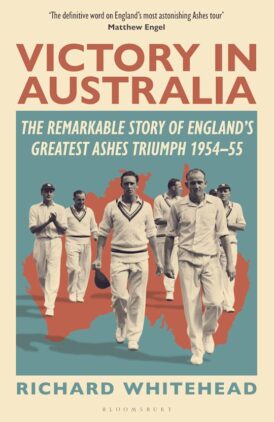Victory in Australia
Martin Chandler |Published: 2025
Pages: 392
Author: Whitehead, Richard
Publisher: Bloomsbury
Rating: 5 stars

Cricket history, or at least Ashes history, repeated itself after both global conflicts of the twentieth century. The first three series after peace returned proved to be easy victories for the Australians before, in 1926 and 1953 England, with a hard earned victory following four draws, finally brought the Ashes home.
There were differences too though. England’s captain in 1926 was a young Kent amateur, Percy Chapman, and he followed up his one win with another, Australia being comprehensively beaten 4-1 in 1928/29. The man tasked with emulating Chapman in 1954/55 was cut from a very different cloth, the veteran Yorkshireman Len Hutton.
In his introduction to this faultless account of Hutton’s tour Richard Whitehead quotes the England captain, who was undertaking his third Ashes tour, as saying the grounds are hard, the ball is hard , the men are hard – you need to be harder than they are to beat them.
That distinction out of the way at first glance the comparisons with Chapman’s tour continue, in that both teams achieve what at initially looks like a comfortable victory, Chapman’s men 4-1 and Hutton’s 3-1, which would certainly have been 4-1 had Tests in Australia still been timeless after the war.
Both first Tests also began with an innings victory, Chapman’s side margin of victory being the small matter of an innings and 675 runs. The innings victory in 54/55 was, on the other hand, Australia’s. Hutton picked the wrong team, made the wrong decision at the toss and lost by an innings and 154. Frank Tyson’s figures were 1-160.
And it didn’t get much better at the start of the second Test as Hutton, invited to bat by opposite number Ian Johnson despite what happened in the first Test, saw his team subside to 154 all out. It couldn’t get any worse for Hutton after that, and it certainly didn’t. The turning point seems to have come in England’s second innings when Ray Lindwall poleaxed Tyson with a bouncer.
Events then turned in England’s favour. The whole team contributed, but the most memorable individual efforts came from Tyson, strike partner Brian Statham and the amateur batsmen Peter May and Colin Cowdrey.
As befits an exciting series in the days before technology permitted the entire world to watch the drama unfold there were as many as a dozen accounts of the tour published. Two of them were written by John Arlott and ‘Jim’ Swanton, but the other writers were an authoritative bunch as well and, interestingly, included Margaret Hughes, who had a few problems being accepted in the previously all male domain of the press box.
There have also been some later accounts of the tour, including one by Alan Hill, biographer of four of the tourists, May, Alec Bedser, Trevor Bailey and Johnny Wardle as well as Jim Laker and Tony Lock, whose omissions from Hutton’s party also loom large in the narrative. Tyson too, in 2004 so long after he settled in Australia, also produced a retrospective account of the trip.
But that was by no means all. Many of the players involved on both sides wrote autobiographies, and a goodly number more than one. Many of them and others have been the subject of biographies, as has Geoffrey Howard, the England manager.
All of which, before I even opened the book, struck me as presenting a particular challenge to Whitehead. This one was not a little known series or forgotten series, and the bare bones of what happened are familiar to many. But what, on reflection, has been forgotten is just what a thrilling series it was.
Whitehead clearly read all the books that touched on the contest, but in addition he also followed the build up to the series and the play itself through the eyes of the journalists who reported newspapers on both sides of the world. The result was that despite the fact that, Neil Harvey apart, there is no one left alive who played in the series, Whitehead could have learnt little more if he had had the opportunity to interview the protagonists.
The result is a book that it is very easy to get completely immersed in. As I say the 1954/55 series is one I thought I knew well, but almost every paragraph either reminded me of something I had forgotten, or alternatively told me something that was most definitely new to me. And even in respect of those aspects I had correctly recalled I was frequently given new insights. To use the words of Leo McKinstrey, quoted on the back of the jacket, the book is indeed a masterpiece of research and narrative skill.
Victory in Australia is the latest book to appear in the relatively new retrospective tour account genre, a remarkably high percentage of which have been quite outstanding. How does it compare with the best of the others? One day I might try and rank them, but not today. For now I will simply give the book the five stars that, even if the photographs are a little disappointing, it undoubtedly merits.






Leave a comment